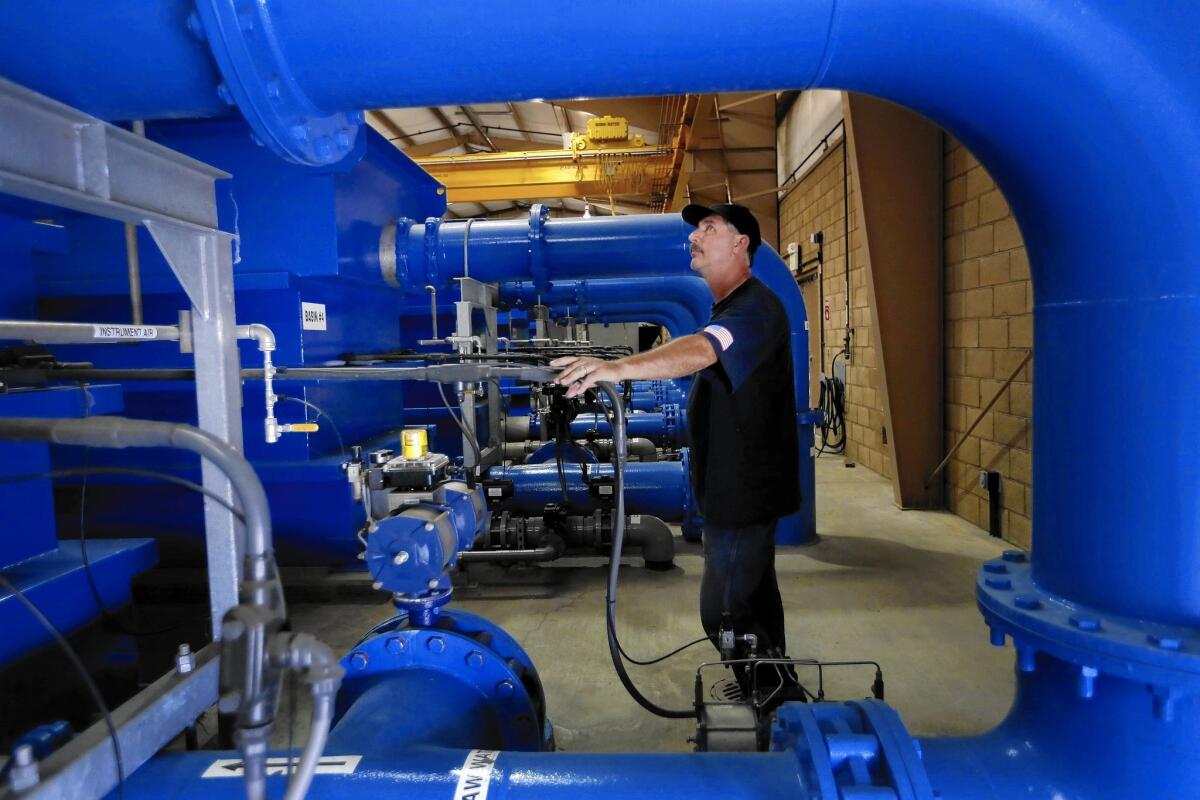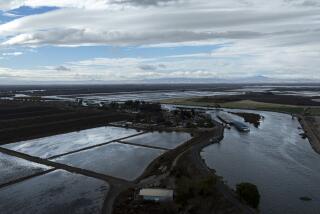Water-independent Riverside fights 28% reduction order

Chief water system operator Cliff Bellinghausen at Riversideâs John W. North Water Treatment Plant. The city considers itself âwater independent,â and officials have balked at an order from the state to cut back significantly on water use.
For decades, Riverside has worked to be what officials consider âwater independentâ by consolidating groundwater rights and building water treatment facilities.
And in recent years, the city-owned public utility appears to have achieved that goal. It has not imported water from outside sources for about seven years, and instead has relied on abundant groundwater, which officials say has been undiminished by the drought.
So when state officials ordered the city, along with water suppliers up and down the state, to cut back significantly on water use, officials balked.
âWe are 100% independent in terms of our water supply,â Mayor Rusty Bailey said. âWe believe we should be treated differently than everybody else. Itâs not a one-size-fits-all situation.â
The city sued the state this month after it learned it would be rejected for inclusion in a special reduction tier that allows suppliers to reduce water use by just 4% if they do not import water and have at least a four-year supply.
State officials reserved the 4% tier (significantly lower than the 28% by which Riverside Public Utilities was ordered to reduce) for suppliers that use surface water, not groundwater. That eliminated Riverside and several other water suppliers that had said they would be able to meet the requirements if groundwater was included.
âGroundwater for many areas is the savings account available during times of drought, and the limited 4% reduction tier is not available for communities who are relying on that savings account to weather the drought,â Michael Lauffer, attorney for the state water board, said in a statement.
Only five districts, all in Northern California, have been approved for the 4% tier. A ruling on the city of Blytheâs application is still pending, according to a state water board spokesman.
So far, Riverside is the only utility to pursue legal relief over the issue, but it is not alone in thinking it should have been included.
Several districts, in fact, told the state water board earlier this year that if groundwater was included they too could meet the requirements for the lower tier. But officials at some of those agencies said pushing back like Riverside could send mixed messages to customers about the importance of reducing water usage.
âItâs a conflicted message that youâre fighting to get into the 4% tier. If youâre successful, then what happens to your conservation efforts?â said Todd Corbin, general manager of the Jurupa Community Services District, which provides water to about 29,000 customers a few miles west of Riverside.
Officials there have talked to Riverside officials about joining the legal action, though no decisions have been made, he said. Like Riverside, the district has been ordered to reduce water use by 28%.
In Big Bear Lake, Reggie Lamson, general manager of the Department of Water and Power, said his agency also doesnât import water and relies on a well-managed groundwater source. But he said he accepted a state officialsâ response when he was told that âthey didnât have time to go ⦠check out each basin individually and say, âOh, yeah. Theyâre an exception.ââ
âThe drought is serious, so OK, weâll try to help out,â he said.
In Lake Arrowhead, officials also applied for and were rejected from the tier because while the vast majority of that communityâs water comes from the lake, about 10% is groundwater. Officials there were also approached by Riverside about joining in the suit but decided against it because they felt the 16% reduction tier they were given is manageable, said Catherine Cerri, finance manager for the Lake Arrowhead Community Services District.
âItâs definitely something we can achieve,â she said.
Richard Atwater, executive director of the Southern California Water Committee, said itâs important to remember that water levels in groundwater basins throughout the state have been falling during the drought.
âWe all need to conserve water, whether youâre pumping local wells or not,â he said. âEven in our really well-managed, adjudicated basins, I think conservation is important.... Everybodyâs interconnected.â
Riverside officials say their continued efforts for more than a century to create an independent water supply should be rewarded. In 2008, the city opened a $25-million water treatment plant that allowed it to tap into previously unusable water, and since then, it has not imported any water from either the State Water Project or the Colorado River, officials said.
The city has also taken steps over the years to reduce water use, including offering a turf removal program and hiring an educator to talk to students about water conservation.
Recently, the City Council also approved restricting outdoor watering to three days a week.
Bailey said the city is in talks with state officials and is hopeful they will come to a resolution to include it in the 4% tier and avoid moving forward with the suit. Given the steps the city has already taken to reduce water usage in recent years, he said, itâs âprobably impossibleâ to reach the 28% reduction the state is asking for.
âI believe Riverside is a best practice when it comes to water conservation,â he said. âAnd I would love for the state to look more closely at what weâve accomplished and to show that to other agencies across the state of California.â
Twitter: @palomaesquivel
More to Read
Sign up for Essential California
The most important California stories and recommendations in your inbox every morning.
You may occasionally receive promotional content from the Los Angeles Times.











